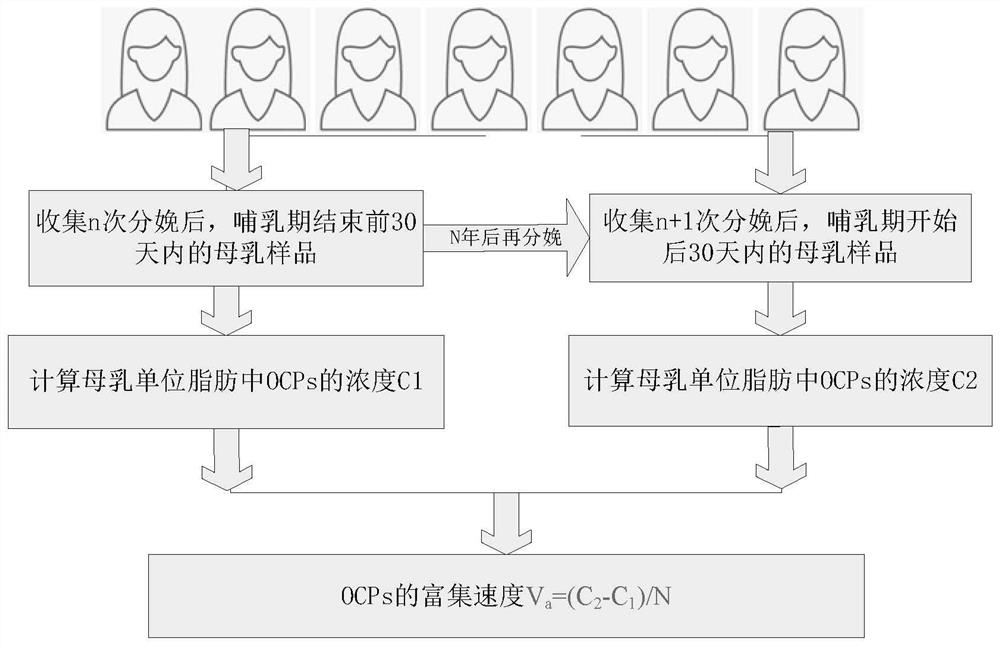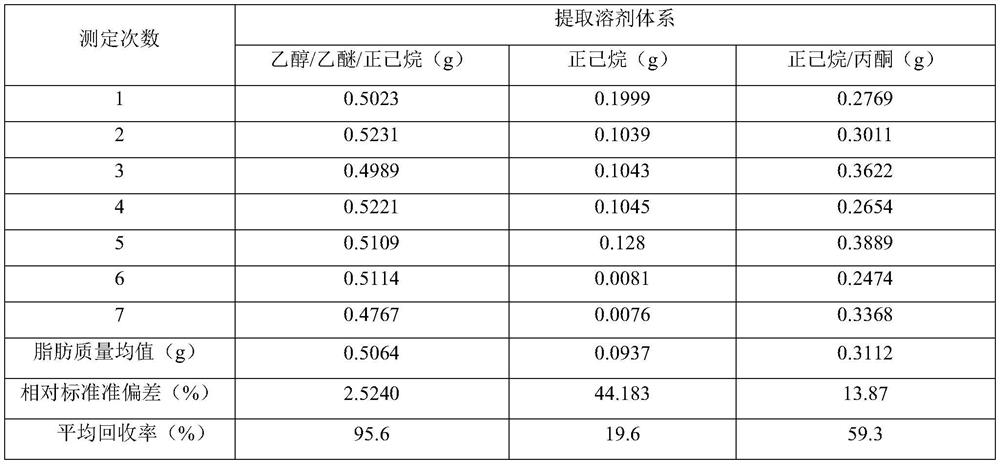Method for determining enrichment rate of organochlorine pesticides of human body
A technology of organochlorine and enrichment rate, applied in the direction of measuring devices, instruments, scientific instruments, etc., can solve the problem that the intake of pesticides cannot accurately represent or correspond to the accumulation of pesticides or the accumulation of pesticides in the body, and it is difficult to ensure that the concentration of representative pesticides is consistent Problems such as stability and data stability, cumulative error of calculation results, etc., to achieve the effect of small measurement error, improved solvent system, and fewer experimental steps
- Summary
- Abstract
- Description
- Claims
- Application Information
AI Technical Summary
Problems solved by technology
Method used
Image
Examples
Embodiment 1
[0024] Breast milk samples were collected from lactating women during two consecutive lactation periods. Collect breast milk samples within 30 days after the start of each lactation period and within 30 days before the end of each lactation period. A total of four breast milk samples were collected, about 20 mL were collected in brown glass bottles, sealed, and stored in a freezer at -20°C. Before sample analysis, take the sample out of the refrigerator, return to room temperature, and shake well for later use.
[0025] Accurately pipette 10 mL of the above four samples respectively, record the accurate mass m of each sample, and transfer the sample to a 100 mL separating funnel without damage. Add U.S.EPA 8081 / 8270 substitute 2,4,5,6-tetrachloro-m-xylene and dibutyl chlorendate mixture (40μL×1.0μg / mL); shake thoroughly with 5mL ammonia water and 10mL ethanol Mix well, 15mL of diethyl ether is fully shaken for mixing, 25mL of n-hexane is fully shaken for 100 times, and then t...
Embodiment 2
[0028]Breast milk samples were collected from lactating women during two consecutive lactation periods. Collect breast milk samples within 30 days after the start of each lactation period and within 30 days before the end of each lactation period. A total of four breast milk samples were collected, about 20 mL were collected in brown glass bottles, sealed, and stored in a freezer at -20°C. Before sample analysis, take the sample out of the refrigerator, return to room temperature, and shake well for later use.
[0029] Accurately pipette 10 mL of the above four samples respectively, record the accurate mass m of each sample, and transfer the sample to a 100 mL separating funnel without damage. Add the U.S.EPA 8081 / 8270 substitute 2,4,5,6-tetrachloro-m-xylene and dibutyl chlorhexenate in sequence (40μL×1.0μg / mL); 50mL of n-hexane shake well to extract 100 After the second time, let it stand for layering. The upper organic phase was collected and the aqueous breast milk sample...
Embodiment 3
[0032] Breast milk samples were collected from lactating women during two consecutive lactation periods. Collect breast milk samples within 30 days after the start of each lactation period and within 30 days before the end of each lactation period. A total of four breast milk samples were collected, about 20 mL were collected in brown glass bottles, sealed, and stored in a freezer at -20°C. Before sample analysis, take the sample out of the refrigerator, return to room temperature, and shake well for later use.
[0033] Accurately pipette 10 mL of the above four samples respectively, record the accurate mass m of each sample, and transfer the sample to a 100 mL separating funnel without damage. Add the U.S.EPA 8081 / 8270 substitute 2,4,5,6-tetrachloro-m-xylene and the mixed standard of dibutyl chlorendate (40μL×1.0μg / mL); 75mL n-hexane / acetone (2: 1, volume ratio) After fully shaking and extracting for 100 times, let it stand for stratification. Collect the upper organic phas...
PUM
 Login to View More
Login to View More Abstract
Description
Claims
Application Information
 Login to View More
Login to View More - R&D
- Intellectual Property
- Life Sciences
- Materials
- Tech Scout
- Unparalleled Data Quality
- Higher Quality Content
- 60% Fewer Hallucinations
Browse by: Latest US Patents, China's latest patents, Technical Efficacy Thesaurus, Application Domain, Technology Topic, Popular Technical Reports.
© 2025 PatSnap. All rights reserved.Legal|Privacy policy|Modern Slavery Act Transparency Statement|Sitemap|About US| Contact US: help@patsnap.com



